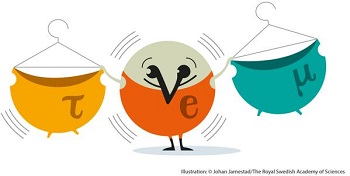The Royal Swedish Academy of Sciences has awarded the Nobel Prize in Physics for 2015 to the scientists who discovered neutrino oscillations, which show that neutrinos have mass.

The Nobel Laureates are Takaaki Kajita from the Super-Kamiokande Collaboration at the University of Tokyo and Arthur B. McDonald from the Sudbury Neutrino Observatory Collaboration at the Queen’s University.
The scientists have made key contributions towards experimental research which has demonstrated that neutrinos change identities.
Neutrinos must have mass for this metamorphosis to take place and the experiment conducted demonstrated the existence of neutrino oscillations. Around the year 2000, Takaaki Kajita discovered that neutrinos in the atmosphere switch between two identities when traveling towards the Super-Kamiokande detector in Japan.
Around the same time, Arthur B. McDonald had led a group of researchers in Canada who demonstrated that neutrinos coming from the Sun possessed a different identity when they reached the Sudbury Neutrino Observatory and did not disappear on their way to Earth.
This discovery resolved the neutrino puzzle that had been troubling physicists for decades. Measurements conducted on Earth revealed that nearly two thirds of the neutrinos that had to exist according to theoretical calculations were missing.
The experiments conducted by Takaaki Kajita and Arthur B. McDonald revealed that the neutrinos had not been detectable as they had changed identities. This was a historic discovery in the field of particle physics.
Announcement of the Nobel Prize in Physics 2015
For more than two decades, the Standard Model of particle physics had been very successful and had stood up to various experimental challenges. This model considers neutrinos to have no mass but the prize-winning discovery demonstrates that this model is not the complete theory of the fundamental constituents of the universe.
The discovery has provided an important insight into the hidden world of neutrinos. In the cosmos, photons are the most numerous particles, followed by neutrinos. Both photons and neutrinos constantly bombard the Earth.
Neutrinos are produced by nuclear reactions which take place inside the Sun or by a reaction which takes place between the Earth’s atmosphere and cosmic radiation.
Neutrinos are considered to be the most elusive fundamental particles in nature. They can pass through nearly anything, with thousands of billions of neutrinos passing through our bodies every second.
The discoveries about neutrinos could possibly change our perception about the universe’s structure, its history and its future fate.